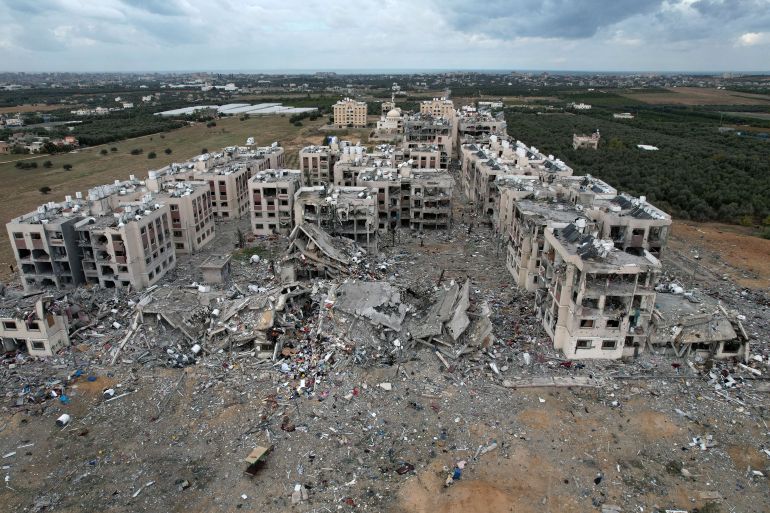Israel signals bombardment of northern Gaza set to end
The Israeli military has ‘dismantled’ Hamas in the north, but suggests the onslaught will continue in the rest of Gaza.

Israel has signalled that it is ready to end its bombardment of northern Gaza, saying it has “dismantled” Hamas in that part of the Gaza Strip.
The claim from the military spokesperson that Israel has nullified the Palestinian armed group in the north of the enclave extends the signs that it plans to shift to a more precise campaign. It came as top American and European envoys toured the region on Sunday, stepping up the international pressure over the mounting death toll and humanitarian crisis in Gaza.
Keep reading
list of 4 itemsHezbollah says will keep fighting if Israel presses on with assault on Gaza
US students use graduation to stand with Palestine
Turkey’s Erdogan meets Greek PM, sees ‘no unsolvable problems’ in ties
The spokesperson said Israeli forces have now completely dismantled Hamas’s “military framework” in northern Gaza after killing about 8,000 fighters, and will now end major combat operations.
Hamas fighters “without a framework and without commanders” are still present, he continued, and scattered fighting is to be expected, along with rockets sporadically being launched towards Israel. But Hamas no longer operates in an organised manner in the area, he asserted.
The military did not address troop deployments in northern Gaza going forward, but the spokesperson said it will “continue to deepen the achievement” in the area.
However, the onslaught in the rest of the enclave, including the south, to which Israel previously pushed Palestinians labelling it a safe area, is set to continue.
“We are now focused on dismantling Hamas in the centre of and south of the strip,” the spokesperson said.
The Israeli military’s assault using drones, missiles and ground forces was launched following Hamas’s attack on October 7, which killed about 1,140 people in Israel and saw some 240 taken captive.
The latest figures on casualties in Gaza show that close to 23,000 people have been killed and more than 58,000 wounded. Many more are missing, feared under the rubble of bombed buildings. Most of the 2.3 million population has been displaced, and are struggling for food and shelter.
Spillover
Amid these figures and the ongoing humanitarian crisis, pressure has been growing on Israel for weeks to end its indiscriminate warfare.
In particular, the United States, Israel’s main backer, is reported to be pressing Tel Aviv to end its tactic of widespread bombardment, and the associated civilian casualties.
However, Israel has remained defiant. Prime Minister Benjamin Netanyahu has insisted the war will not end until the objectives of eliminating Hamas, getting Israel’s hostages returned, and ensuring that Gaza will no longer be a threat are met.
The military spokesperson reiterated that stance, stating that “fighting will continue during 2024. We are operating according to a plan to achieve the war’s goals, to dismantle Hamas in the north and south.”
Yet, as the death toll mounts, the risk that the war could spark a regional conflagration looks to be rising. Violence is flaring in the occupied West Bank, on the Israel-Lebanon border, in Iraq and Syria, and in the Red Sea.
US Secretary of State Antony Blinken and Josep Borrell, the EU’s top diplomat, are currently in the Middle East seeking to prevent Israel’s high-intensity campaign from spilling over into a wider war across the region.
On his fourth visit to the region in three months, Blinken is stressing that Israel should adjust its military operations to reduce civilian casualties and significantly boost humanitarian aid into Gaza.
However, many in the region suggest that they expect Washington to do more to rein in Israel, which is receiving billions of dollars worth of support from the US. Jordan’s King Abdullah on Sunday warned the US secretary of state of “catastrophic repercussions” from the continuation of Israel’s military campaign.